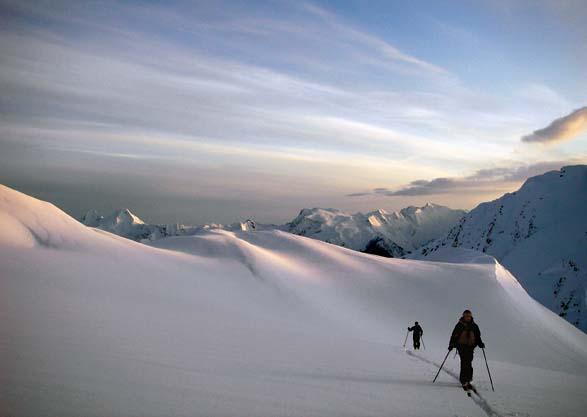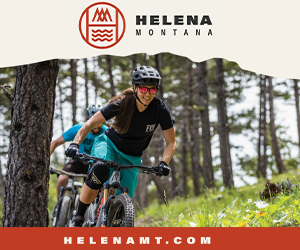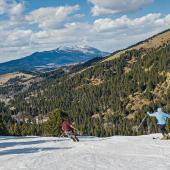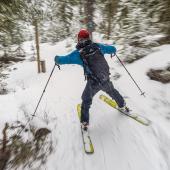Backcountry Skiing 101
Think for a moment about the last time you endured 60-mph wind gusts. Or the last time you post-holed up a 1,500-foot, 35-degree slope. Did you sweat like you were in a sauna even though the temperature was below freezing? How long has it been since you booted up perfect Styrofoam snow—you know, the kind that allows for that sublime toe-kick and climb?
That was my experience a short while ago, climbing and skiing Hardscrabble Peak in the Bridgers. The Styrofoam snow led up a couloir to a wind-scoured summit, and the relentless wind ravaged every piece of my exposed skin. The turnaround point was barren of any life except my own; the wind was blowing so hard it was a challenge just to stand. And even though I was below 10,000 feet, it felt like I was on top of a Himalayan giant.
It became time to turn around and ski thousands of feet of awe-inspiring snow. The first few turns were sugary, bottomless, rotten snow. After a short five turns, the snow stiffened and became a creamy windblown powder. The next 75 turns were challenging, but extremely gratifying, and within moments I was at the bottom of a sweat-packed climb, grinning from ear to ear.
If my experience sounds fun, or at least rousing enough to consider, then maybe backcountry skiing is for you. But just like those third- and fourth-year college classes, backcountry skiing has prerequisites. Surprisingly enough, the ability to ski is not one of them.
The Love of a Good Sweat
However trite, “earn your turns” is a phrase that accurately describes backcountry skiing. To ski 3,000 feet of vertical in the backcountry, you must climb three thousand feet of vertical—and concurrently build up a sweat. If you’re lucky, the 3,000 feet includes a foot or two of new snow to break through, making the ascent that much harder. The climb may include long stretches of 30-35 degree slopes, breaking through four-foot wind-drifts, and negotiating steep, rocky ridgelines. Imagine hiking the Ridge at Bridger Bowl four or five times in one day—but starting that first hike from the parking lot.
All or any of these factors can make even well-conditioned athletes’ glands feel like spring runoff. Anyone who enjoys endurance and pushing the body to its physical capacity will enjoy this aspect of backcountry skiing. Keep in mind that every outing doesn’t need to include three thousand feet of vertical. For some, just a 500-foot climb and ski will be sufficient. However, the higher and harder you go, the more turns you will earn.
An Understanding of Snow Dynamics
Snow science cannot be summed up in one article, and very few skiers are avalanche experts; however, anyone traveling in avalanche terrain should have a basic understanding of the season’s snowpack.
Throughout the winter season, Mother Nature lays down a wide variety of snow layers. Wind and temperature can drastically metamorphose each layer. Sometimes these changes strengthen the snowpack, making it less likely to avalanche; but just as often these changes weaken the snowpack. When the snowpack is weak, a backcountry skier may be the trigger that sends the snow sliding—the proverbial hair on the snow-camel’s back.
A great way to keep tabs on the winter snowpack is to check your local avalanche-forecasting center. It’s not enough just to check the day before an outing, though. I like to log on to the center’s website a few times a week for the updated avalanche report (the Gallatin National Forest Avalanche Center has a daily email you can sign up for). A continual check of conditions keeps me updated on how the layers of snow are stacking up.
Words and phrases that you may read on the report include: wind-loading, cross-loading, surface hoar, depth hoar, upside-down snow, facets, sun crusts, and rime . These terms, along with many others, are only useful if the reader knows what they mean and how they relate to the current snowpack. You can get the definitions of these and other terms by taking an avalanche course, reading a book about snow and avalanches, or by just logging onto your local forecast center’s website.
Really savvy backcountry skiers will also dig snow pits and study the layers of snow for themselves. After enough study you will be able to recognize strong and weak layers in the season’s snowpack. A wide variety of tests can be performed to assess the stability of the snow. Remember that the test is for that specific area; conditions may be completely different on other slopes.
An Endurance of Extremes
Here you are at the parking lot, getting ready to climb to a beautiful mountain ridge. You know you will be sweating profusely in about 20 minutes, but at the moment you can barely get your gear on because your frozen fingers have all the dexterity of horse hooves. So you start your climb, and the shedding of hats, gloves, and fleece happens quickly. The sweating continues. You’ve already experienced a multitude of body temperatures, and once you reach your stopping point, the deluge of sweat you created while climbing is quickly being cooled by a ten degree, 20 mph ridge-top wind—not a very comfortable condition to say the least. If winds are strong and cold enough, your body can cool at a very dangerous pace.
Extreme weather changes happen whether you are backcountry skiing or skiing at a resort. With 40-50 mph gusts, clear blue skies can suddenly change to gray. Soon the air is choked with snow. Unlike your cozy neighborhood ski resort, in the backcountry there is no lodge and in most cases you just have to endure the storm.
When you’re ready to take off the skins and head down, what you see beneath your skis is a couple thousand feet of knee-deep, light-as-air powder. So you take your first turn and puncture a hidden crust that grabs your skis and sends you tumbling. None of those backcountry ski magazines showed pictures of snow like this. After enduring a few turns on this rock-hard, wind-blown snow, you finally break into that heavenly powder—the snow flowing upward and into your face like campfire smoke. This lasts the majority of the run until you start feeling crusty snow again, just below the good snow. Now you’re skiing lower-elevation snow that has melted during the day but has frozen overnight, and survival skiing begins.
Let’s take the scenario one step further. To get back to the car you need to ski the last 200 feet of vertical on a south-facing slope. It’s been cooked by the sun but not yet frozen like the north-facing slopes. (This will give you good training for your next trip to the Sierras or the Cascades.) For those of you who are not familiar with the term, you are now skiing “Sierra cement,” and you may need to summon all your strength, stamina, and coordination to get through it with any degree of gracefulness.
A Desire for Adventure
Any outdoor activity that requires an individual to sweat profusely, understand snow dynamics, and endure various extremes is an adventure. I have taken many people into the backcountry who could barely link two turns together, but they loved the aforementioned aspects of backcountry skiing. If your main goal is to learn how to ski or get a lot of turns, then backcountry skiing may not be for you. However, if your goal is to have a great adventure, then get out there and “earn your turns."
Ascension STS Climbing Skins–Black Diamond
A good pair of skins can make the difference between a stellar day in the backcountry and the raging renouncement of all things winter. After one too many days slipping backwards down a skin-track, piercing the alpine silence with curses while my friends top out a quarter-mile above, I decided to bite the bullet and pick up a pair of Black Diamond Ascension STS skins. What a difference. These beauties stick securely to my skis regardless of temperature, grab the snow like lynx paws, and have a handy rear-clip mechanism that lets me peel off the skins without removing my skis (the reverse technique of attaching skins with skis still on is inadvisable, unless you enjoy being laughed at). And although cutting skins to size is arguably an art form, the Black Diamond instructions and sizing kit make it a heck of a lot easier for first-time cutters. $113-$168, depending on size; bdel.com.
Speed Pro 240 TECH Avalanche Probe–G3
Avalanche probes are kind of like helmets—we all know we should use them, but most of us don’t. At best, we choose some mini-probe that fits inside a shovel handle, or ski poles that convert. These options are fine, but when your buddies get buried and time is of the essence, don’t you owe it to them to be as well-equipped as possible? Enter the G3 Speed Pro 240 TECH avalanche probe. This baby may be big, burly, and stick outside your cute little 50cc Ridge pack; but it’s also the best tool to probe for a buried avalanche victim, hands-down. With a super quick toss-pull-screw motion, six lightweight aluminum sections come together to provide a full 240cm-long probe—that’s nearly eight feet of search depth. Easy-to-read depth markings help decipher between ground and victim, and a handy carrying case offers compact and streamlined storage. A host of little touches, like the coarse-edged nut for all-condition grip, help pull this probe even farther away from the rest. $90; genuineguidegear.com.
-Mike England












